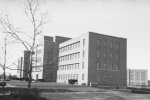Difference between revisions of "Portal:Featured Article Of The Week"
M-Explorer (talk | contribs) |
M-Explorer (talk | contribs) |
||
| Line 1: | Line 1: | ||
{{FAformat | {{FAformat | ||
| − | |Title= | + | |Title= Philadelphia State Hospital |
| − | |Image= | + | |Image= ByBerry TitleBar2.jpg |
|Width= 150px | |Width= 150px | ||
| − | |Body= | + | |Body= This large complex has its humble beginnings as a small work farm for the mentally challenged in a section of Philadelphia called Byberry, in 1906. Construction for a large asylum complex was in progress from 1910 to the mid-1920s, which included several dormitories, an infirmary, kitchens, laundry, administration, and two coal power plants. Many buildings were built with scrap and other materials because of the World War I shortage, which resulted in quick deterioration of many of the structures in the complex. |
| − | The | + | The Philadelphia Hospital for Mental Diseases opened its doors to its first patient in 1907. Its population quickly grew, but with this also came tales of abuse and neglect. With insufficient funds, the asylum had quickly fallen into disrepair, and patients wound up sleeping in hallways, and raw sewage was found on the bathroom floors during an inspection of the facility. |
| − | + | In 1936, the institution was finally signed over to the state, although it did nothing to alleviate the problems in the facility until the early 1940s. This is when the new owners of the institution sought to change the old Byberry into the new "Philadelphia State Hospital," and the facility underwent an enormous expansion at the rate of one building each year until 1953. Still, articles such as Albert Deutch's 1948 publication "Shame of the States," articles such as Life's "Bedlam 1946" and Times' "Herded Like Cattle" (1948) described life inside the hospital as despicable. [[Philadelphia State Hospital|Click here for more...]] | |
}} | }} | ||
Revision as of 03:58, 9 May 2011
Featured Article Of The Week
Philadelphia State Hospital
This large complex has its humble beginnings as a small work farm for the mentally challenged in a section of Philadelphia called Byberry, in 1906. Construction for a large asylum complex was in progress from 1910 to the mid-1920s, which included several dormitories, an infirmary, kitchens, laundry, administration, and two coal power plants. Many buildings were built with scrap and other materials because of the World War I shortage, which resulted in quick deterioration of many of the structures in the complex.
The Philadelphia Hospital for Mental Diseases opened its doors to its first patient in 1907. Its population quickly grew, but with this also came tales of abuse and neglect. With insufficient funds, the asylum had quickly fallen into disrepair, and patients wound up sleeping in hallways, and raw sewage was found on the bathroom floors during an inspection of the facility.
In 1936, the institution was finally signed over to the state, although it did nothing to alleviate the problems in the facility until the early 1940s. This is when the new owners of the institution sought to change the old Byberry into the new "Philadelphia State Hospital," and the facility underwent an enormous expansion at the rate of one building each year until 1953. Still, articles such as Albert Deutch's 1948 publication "Shame of the States," articles such as Life's "Bedlam 1946" and Times' "Herded Like Cattle" (1948) described life inside the hospital as despicable. Click here for more...
